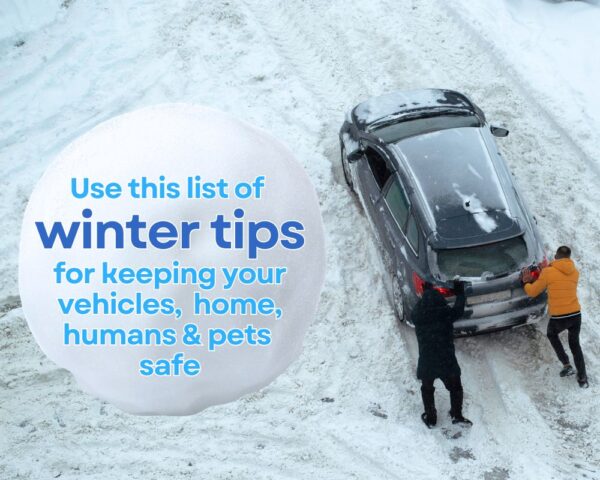
Take a minute to at least skim through this list, so you’ll have a good idea of whether you are prepared for extreme winter weather!
Your vehicle, home, humans, and pets are depending on you to learn this information. The following are winter tips you didn’t know you needed – because you’re from the South.
Here in Arkansas, we don’t typically have the extreme ice, snow and temperatures like up north. But it does occasionally happen, so here are some simple things you need to learn that will help tremendously.
See tips below for:1. your vehicle, 2. your home, 3. your humans, and 4. your pets…
1. your vehicle
Don’t drive in inclement weather unless you absolutely have to. Arkansas as a state doesn’t have the same equipment that states up north do, so the roads don’t always get adequate maintenance when covered in ice or snow. Here are some pointers to keep you from getting into trouble on the road.
A. Exhaust
This is THE most important tip. I know you want to get that car or truck warm, but you have to consider the surroundings.
If your vehicle is parked outside in your driveway, your job or anywhere while it’s snowing, there’s a possibility of the snow getting higher than your exhaust pipe. Don’t start your car before clearing the snow away from your exhaust pipe(s). If there’s snow blocking the air flow, the exhaust fumes will seep into the interior of your car and be deadly.
If you park inside, don’t start your car before you open the garage door. This could also lead to inhaling deathly toxic fumes, due to the enclosed area.
B. Driving
Drive extra slow in icy weather – like 15 in a 40 mph zone.
Don’t tailgate. Stay three car lengths away.
When using your brakes, only tap them, so you don’t spin or slide.
If you are sliding, shift the vehicle into Neutral and try to drift to a safe place at the curb.
C. Frozen Parts
Wipers – If your vehicle is going to be left outside for any length of time, pull up the windshield wipers and leave them up. You can also cover your windshield with cardboard.
Windshield – If you didn’t prep ahead, you can quickly defrost your windshield by using water and alcohol. DON’T use hot or even warm water, since it will likely crack your window. You can use a spray bottle with 2 parts rubbing alcohol and 1 part water. Spray the solution on your window and it will melt frost away.
Door – Maybe you remembered the wipers and the windows, but now the door is frozen shut. Don’t tug on the handle, since it can break. Try pushing inward to break the seal of the ice. If your handle or keyhole are frozen, you can pour warm water over it (just not on the window).
D. Preparedness for Vehicles
Try as you may, you might still get stuck. Here are some things that you can do to make things better while you wait for help or maybe even get you unstuck:
Make sure you have plenty of gas to get to your destination and back. You don’t want to run out. Consider that you might be stuck in traffic for a while or stranded and needing the heat.
Keep rock salt or just regular salt to melt ice under a stuck tire.
Keep kitty litter or sand to make friction under the tire.
If you didn’t think of those things, you can use a floor mat or towel under your tire.
You can also let a little bit of air out of the tires. This will help the tires grip the road or ground surface.
E. Preparedness for Humans
If you’re stuck somewhere, it could be a while before help comes along. Obviously, don’t leave without dressing warm and having coverings for basically every part of your body. But also bring these things:
-
- Food, snacks, water
- Blankets, towels
- Extra Socks, pants, shirt, gloves
KEEP READING BELOW
2. your house
These are a few tips to save your pipes, save energy or to make do in a pinch if you do lose water or power.
Pipes
Cover your outdoor faucets to protect them from freezing, so hopefully a pipe won’t burst. You can use a foam cup that’s made specifically for that purpose, or a towel or even a shirt.
Leave your indoor faucets dripping when it’s under 30 degrees. Or when it’s under 20 degrees, let the water lightly stream.
Know where your water meter is and how to turn it off in case a pipe does burst. (Ask me how I know.)
Energy
Electric and natural gas companies will sometimes urge users to conserve energy in an effort to avoid widespread blackouts.
Here’s how to use less energy:
Keep your thermostat on 60-65 degrees while you’re awake. Drop the temp by 5-10 degrees lower if you will be away for several hours or while you sleep. Double up on those blankets or invite all the pets to sleep in the bed!
Let’s do something about your seeping cracks. Use towels, blankets or pillows for insulation around windows and doors, where your warm air might be seeping out. Push the towels against the cracks at the bottom. You can also pick up the end of long curtains and push them into the corners of the window sill.
Check your clothes dryer vent outside to make sure it isn’t covered with snow. Dryer lint can get trapped there and cause a fire.
Keep your devices charged in case of an outage. That brings us to….
If your electricity does go out:
Use candles to keep warm. If you have an empty clay pot, you can suspend it above one or more candles to make the heat radiate farther. Be very careful with fire safety though!
Keep all residents in one small room to share body heat. This may mean everyone sleeps in one living room.
Close off vents other rooms, close the doors and push a towel against the door in the floor.
You can take some groceries from the refrigerator outside so they won’t spoil. But be careful with liquids and beverages. Soda and beer can explode if they get under 30 degrees. Also, liquids that are in a glass container may freeze solid and expand too much and break the glass.
3. your humans
Here are a couple of tips for keeping humans comfy.
Dress in layers even in the house. Use a tight layer underneath – tight socks, leggings, long underwear, a t-shirt or tank. Use loose layers on top – big or fluffy socks, jeans, sweatpants, pajama pants, hoodie, sweater. This will keep you warm in a cooler house. When you go out, add a coat, scarf, hat and gloves.
Use a humidifier or you can simmer water on the stove. The humidity helps the house retain heat and keeps its residents from getting chapped lips and sore nose. It’s still a good idea to keep chap stick and lotion handy.
Check on your neighbors, friends and family who may be at risk.
4. your pets
Pets need shelter in extreme cold.
Bring them inside even if they are normally outside animals OR if you have an insulated shelter for them, like a doghouse or barn, that will work, as long as the breeze can’t get in.
Your dog(s) will need to go outside for their business, but limit it to 10 minutes or less.
Some dogs won’t want to “go” in the snow because they are too small or short. Think ahead before it snows – use a board to cover an area so that you can lift it and have grass that they might use.
These are all the tips I have for now. If you have more, please put them in the comments!




